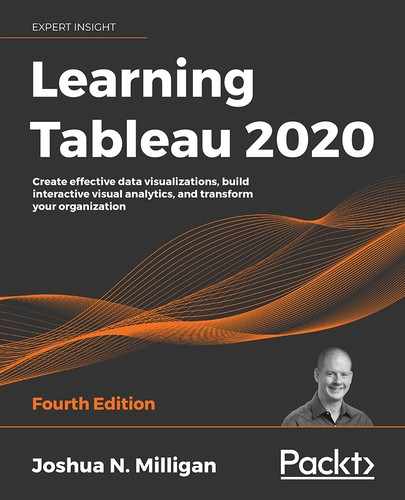14
Structuring Messy Data to Work Well in Tableau
So far, most of the examples we've looked at in this book assume that data is structured well and is fairly clean. Data in the real world isn't always so pretty. Maybe it's messy or it doesn't have a good structure. It may be missing values or have duplicate values, or it might have the wrong level of detail.
How can you deal with this type of messy data? In the previous chapter, we considered how Tableau's data model can be used to relate data in different tables. We will consider Tableau Prep Builder as a robust way to clean and structure data in the next chapter. Much of the information in this chapter will be an essential foundation for working with Tableau Prep.
For now, let's focus on some of the basic data structures that work well in Tableau and some of the additional techniques you can use to get data into those structures. We'll keep our discussion limited to native Tableau features in this chapter, but much of what you learn will apply to Tableau Prep in the next. By the end of this chapter, you'll have a solid foundation of understanding what constitutes a good data structure. Knowing which data structures work well with Tableau is key to understanding how you will be able to resolve certain issues.
In this chapter, we'll focus on some principles for structuring data to work well with Tableau, as well as some specific examples of how to address common data issues. This chapter will cover the following topics:
- Structuring data for Tableau
- The four basic data transformations
- Overview of advanced fixes for data problems
We'll start by discussing which data structures work well for Tableau.
Structuring data for Tableau
We've already seen that Tableau can connect to nearly any data source. Whether it's a built-in direct connection, Open Database Connectivity (ODBC), or the use of the Tableau data extract API to generate an extract, no data is off limits. However, there are certain structures that make data easier to work with in Tableau.
There are two keys to ensure a good data structure that works well with Tableau:
- Every record of a source data connection should be at a meaningful level of detail
- Every measure contained in the source should match the level of detail of the data source or possibly be at a higher level of detail, but it should never be at a lower level of detail
For example, let's say you have a table of test scores with one record per classroom in a school. Within the record, you may have three measures: the average GPA for the classroom, the number of students in the class, and the average GPA of the school:
| School | Classroom | Average GPA | Number of Students | Number of Students (School) |
|
Pickaway Elementary |
4th Grade |
3.78 |
153 |
1,038 |
|
Pickaway Elementary |
5th Grade |
3.73 |
227 |
1,038 |
|
Pickaway Elementary |
6th Grade |
3.84 |
227 |
1,038 |
|
McCord Elementary |
4th Grade |
3.82 |
94 |
915 |
|
McCord Elementary |
5th Grade |
3.77 |
89 |
915 |
|
McCord Elementary |
6th Grade |
3.84 |
122 |
915 |
The first two measures (Average GPA and Number of Students) are at the same level of detail as the individual record of data (per classroom in the school). Number of Students (School) is at a higher level of detail (per school). As long as you are aware of this, you can do a careful analysis. However, you would have a data structure issue if you tried to store each student's GPA in the class record. If the data was structured in an attempt to store all of the students' GPAs per grade level (maybe with a column for each student or a single field containing a comma-separated list of student scores), we'd need to do some work to make the data more usable in Tableau.
Understanding the level of detail of the source (often referred to as granularity) is vital. Every time you connect to a data source, the very first question you should ask and answer is: what does a single record represent? If, for example, you were to drag and drop the Number of Records (or the Table (Count) field in Tableau 2020.2 and later) field into the view and observed 1,000 records, then you should be able to complete the statement, I have 1,000 _____. It could be 1,000 students, 1,000 test scores, or 1,000 schools. Having a good grasp of the granularity of the data will help you to avoid poor analysis and allow you to determine if you even have the data that's necessary for your analysis.
A quick way to find the level of detail of your data is to put the Number of Records (or the Table (Count) field in Tableau 2020.2 and later) field on the Text shelf, and then try different dimensions on the Rows shelf. When all of the rows display a 1, and the total that's displayed in the lower-left status bar equals the number of records in the data, then that dimension (or combination of dimensions) uniquely identifies a record and defines the lowest level of detail of your data.
With an understanding of the overarching principles regarding the granularity of data, let's move on and understand certain data structures that allow you to work seamlessly and efficiently in Tableau. Sometimes, it may be preferable to restructure the data at the source using tools such as Alteryx or Tableau Prep Builder. However, at times, restructuring the source data isn't possible or feasible. For example, you may not have write access to the database or it may be a cloud-based data source that has a predefined structure. We'll take a look at some options in Tableau for those cases. For now, let's consider what kinds of data structures work well with Tableau.
Well-structured data in Tableau
The two keys to a good structure, which we mentioned in the previous section, should result in a data structure where a single measure is contained in a single column. You may have multiple different measures, but any single measure should almost never be divided into multiple columns. Often, the difference is described as wide data versus tall data.
Wide data
Wide data is not typically a good structure for visual analysis in Tableau.
Wide data describes a structure in which a measure in a single row is spread over multiple columns. This data is often more human-readable. Wide data often results in fewer rows with more columns.
Here is an example of what wide data looks like in a table of population numbers:
| Country Name | 1960 | 1961 | 1962 | 1963 | 1964 |
|
Afghanistan |
8,774,440 |
8,953,544 |
9,141,783 |
9,339,507 |
9,547,131 |
|
Australia |
10,276,477 |
10,483,000 |
10,742,000 |
10,950,000 |
11,167,000 |
Notice that the level of detail for this table is a row for every country. However, the single measure (population) is not stored in a single column. This data is wide because it has a single measure (population) that is being divided into multiple columns (a column for each year). The wide table violates the second key to a good structure since the measure is at a lower level of detail than the individual record (per country per year, instead of just per country).
Tall data
Tall data is typically a good structure for visual analysis in Tableau.
Tall data describes a structure in which each distinct measure in a row is contained in a single column. Tall data often results in more rows and fewer columns.
Consider the following table, which represents the same data as earlier but in a tall structure:
| Country Name | Year | Population |
|
Afghanistan |
1960 |
8,774,440 |
|
Afghanistan |
1961 |
8,953,544 |
|
Afghanistan |
1962 |
9,141,783 |
|
Afghanistan |
1963 |
9,339,507 |
|
Afghanistan |
1964 |
9,547,131 |
|
Australia |
1960 |
10,276,477 |
|
Australia |
1961 |
10,483,000 |
|
Australia |
1962 |
10,742,000 |
|
Australia |
1963 |
10,950,000 |
|
Australia |
1964 |
11,167,000 |
Now, we have more rows (a row for each year for each country). Individual years are no longer separate columns and population measurements are no longer spread across those columns. Instead, one single column gives us a dimension of Year and another single column gives us a measure of Population. The number of rows has increased, while the number of columns has decreased. Now, the measure of population is at the same level of detail as the individual row, and so visual analysis in Tableau will be much easier.
Let's take a look at the difference this makes in practice.
Wide versus tall data in Tableau
You can easily see the difference between wide and tall data in Tableau. Here is what the wide data table looks like in the left Data window:

Figure 14.1: The wide data has a measure for every year
As we'd expect, Tableau treats each column in the table as a separate field. The wide structure of the data works against us. We end up with a separate measure for each year. If you wanted to plot a line graph of population per year, you would likely struggle. What dimension represents the date? What single measure can you use for the population?
This isn't to say that you can't use wide data in Tableau. For example, you might use Measure Names/Measure Values to plot all the Year measures in a single view, like this:
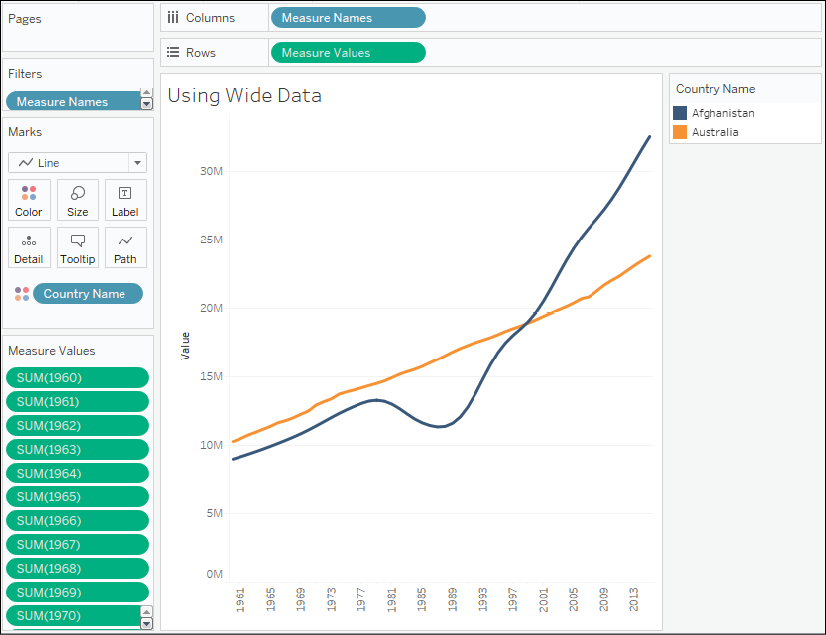
Figure 14.2: The wide data can still be used but in a complex and limited way
You'll notice that every Year field has been placed in the Measure Values shelf. The good news is that you can create visualizations from poorly structured data like this. The bad news is that views are often more difficult to create and certain advanced features may not be available.
The following limitations apply to the view in Figure 14.2 based on the wide data structure:
- Because Tableau doesn't have a date dimension or integer, you cannot use forecasting
- Because Tableau doesn't have a date or continuous field in Columns, you cannot enable trend lines
- Because each measure is a separate field, you cannot use quick table calculations (such as running total, percent difference, and others)
- Determining things such as the average population across years will require a tedious custom calculation instead of simply changing the aggregation of a measure
- You don't have an axis for the date (just a series of headers for the measure names), so you won't be able to add reference lines
In contrast, the tall data looks like this in the Data pane:
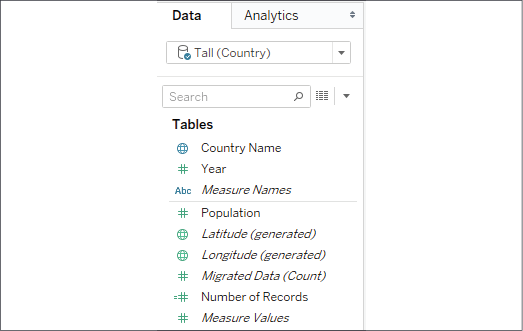
Figure 14.3: The tall data has a Year dimension and a single Population measure
This data source is much easier to work with. There's only one measure (Population) and a Year dimension to slice the measure. If you want a line chart of the population by year, you can simply drag and drop the Population and Year fields into Columns and Rows. Forecasting, trend lines, clustering, averages, standard deviations, and other advanced features will all work in the way you expect them to.
You can see that the resulting visualization is much easier to create in Tableau, using only three active fields:

Figure 14.4: The view is much easier to create in Tableau with the tall data
Next, we'll consider a few other good structures for data that should work well with Tableau.
Star schemas (Data mart/Data warehouse)
Assuming they are well-designed, star schema data models work very well with Tableau because they have well-defined granularity, measures, and dimensions. Additionally, if they are implemented well, they can be extremely efficient to query. This allows for an ergonomic experience when using live connections in Tableau.
Star schemas are so named because they consist of a single fact table surrounded by related dimension tables, thus forming a star pattern. Fact tables contain measures at a meaningful granularity, while dimension tables contain attributes for various related entities. The following diagram illustrates a simple star schema with a single fact table (Hospital Visit) and three dimension tables (Patient, Primary Physician, and Discharge Details):
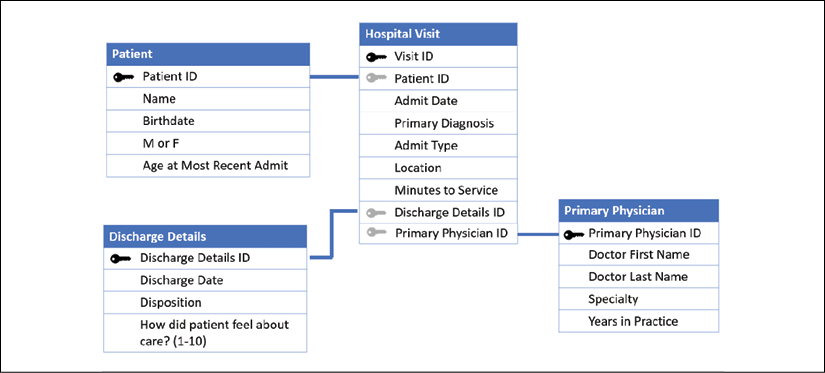
Figure 14.5: A simple star schema
Fact tables are joined to the related dimension using what is often called a surrogate key or foreign key that references a single dimension record. The fact table defines the level of granularity and contains measures. In this case, Hospital Visit has a granularity of one record for each visit. In this simple example, each visit is for one patient who saw one primary physician and was discharged. The Hospital Visit table explicitly stores a measure of Visit Duration and implicitly defines another measure of Number of Visits (as the row count).
Data modeling purists would point out that date values have been stored in the fact table (and even some of the dimensions). They would, instead, recommend having a date dimension table with extensive attributes for each date and only a surrogate (foreign) key stored in the fact table.
A date dimension can be very beneficial. However, Tableau's built-in date hierarchy and extensive date options make storing a date in the fact table, instead, a viable option. Consider using a date dimension if you need specific attributes of dates that are not available in Tableau (for example, which days are corporate holidays), have complex fiscal years, or if you need to support legacy BI reporting tools.
A well-designed star schema allows the use of inner joins since every surrogate key should reference a single dimension record. In cases where dimension values are not known or not applicable, special dimension records are used. For example, a hospital visit that is not yet complete (the patient is still in the hospital) may reference a special record in the Discharge Details table marked as Not yet discharged.
You've already worked with a similar structure of data in the previous chapter, where you experienced the differences of relating tables in the logical layer and the physical layer of the data model. Feel free to return to Chapter 13, Understanding the Tableau Data Model, Joins, and Blends, to review the concepts.
Well-implemented star schemas are particularly attractive for use in live connections because Tableau can improve performance by implementing join culling. Join culling is Tableau's elimination of unnecessary joins in queries, since it sends them to the data source engine.
For example, if you were to place the Physician Name on rows and the average of Visit Duration on columns to get a bar chart of average visit duration per physician, then joins to the Treatment and Patient tables may not be needed. Tableau will eliminate unnecessary joins as long as you are using a simple star schema with joins that are only from the central fact table and have referential integrity enabled in the source, or allow Tableau to assume referential integrity. For tables joined in the physical layer, select the data source connection from the data menu, or use the context menu from the data source connection and choose Assume Referential Integrity. For relationships in the logical layer of the data model, use the performance options for referential integrity for each applicable relationship.
Having considered some examples of good structures, let's turn our attention to some basic transformations that will help us to transform a poorly structured dataset to one with a good structure, which is easier to work with in Tableau.
The four basic data transformations
In this section, we'll give you an overview of some basic transformations that can fundamentally change the structure of your data. We'll start with an overview and then look at some practical examples.
Overview of transformations
In Tableau (and Tableau Prep), there are four basic data transformations. The following definitions broadly apply to most databases and data transformation tools, but there are some details and terminology that are Tableau-specific:
- Pivots: This indicates the transformation of columns to rows or rows to columns. The latter is possible in Tableau Prep only. The resulting dataset will be narrower and taller with fewer columns and more rows (columns to rows) or wider and shorter with more columns and fewer rows (rows to columns).
- Unions: This indicates the appending of rows from one table of data to another, with the matching columns aligned together. The resulting data structure is a single table containing rows from all unioned tables and columns that match between the original tables, along with unmatched columns containing
NULLvalues for tables that did not have them. - Joins: This indicates the row-by-row matching of two or more tables resulting in a data structure that includes columns from all tables. The number of rows is based on the type of join and how many matches are found.
- Aggregations: This indicates the rolling up of a table to a higher level of detail such that there will be a row for each unique set of values for all dimensions used for grouping, along with other values that are aggregated (such as a sum, min, max, or other aggregation).
In order to fully understand these definitions, we'll turn to some illustrations and practical examples.
Pivots (along with some simple data cleaning)
The Excel workbook World Population Data.xlsx, which is included in the Chapter 14 directory of the resources that are included with this book, is typical of many Excel documents. Here is what it looks like:

Figure 14.6: The World Population Data Excel file
Excel documents such as this are often more human-readable but contain multiple issues when used for data analysis in Tableau. The issues in this particular document include the following:
- Excessive headers (titles, notes, and formatting) that are not part of the data
- Merged cells
- Country name and code in a single column
- Columns that are likely unnecessary (Indicator Name and Indicator Code)
- The data is wide, that is, there is a column for each year, and the population measure is spread across these columns within a single record
When we initially connect to the Excel document in Tableau, the connection screen will look similar to Figure 14.7, as follows:

Figure 14.7: World Population Data.xlsx on Tableau's Data Source page
The data preview reveals some of the issues resulting from the poor structure:
- Since the column headers were not in the first Excel row, Tableau gave the defaults of F1, F2, and so on to each column
- The title World Population Data and the note about sample data were interpreted as values in the F1 column
- The actual column headers are treated as a row of data (the third row)
Fortunately, these issues can be addressed in the connection window. First, we can correct many of the excessive header issues by turning on the Tableau Data Interpreter, a component that specifically identifies and resolves common structural issues in Excel or Google Sheets documents. When you check the Use Data Interpreter option, the data preview reveals much better results:

Figure 14.8: Tableau Data Interpreter fixes many of the common issues found in Excel (and similar) data sources
Clicking on the Review the results... link that appears under the checkbox will cause Tableau to generate a new Excel document that is color-coded to indicate how the data interpreter parsed the Excel document. Use this feature to verify that Tableau has correctly interpreted the Excel document and retained the data you expected.
Observe the elimination of the excess headers and the correct names of the columns. However, a few additional issues will still need to be corrected.
First, we can hide the Indicator Name and Indicator Code columns if we feel they are not useful for our analysis. Clicking on the drop-down arrow on a column header reveals a menu of options.
Selecting Hide will remove the field from the connection and even prevent it from being stored in extracts:

Figure 14.9: You can hide fields from the Data Source screen
Second, we can use the option on the same menu to split the Country Name and Code column into two columns so that we can work with the name and code separately. In this case, the Split option on the menu works well and Tableau perfectly splits the data, even removing the parentheses from around the code. In cases where the split option does not initially work, try the Custom Split... option. We'll also use the Rename option to rename the split fields from Country Name and Code - Split 1 and Country Name and Code - Split 2 to Country Name and Country Code, respectively. Then, we'll Hide the original Country Name and Code field.
At this point, most of the data structure issues have been remedied. However, you'll recognize that the data is in a wide format. We have already seen the issues that we'll run into:

Figure 14.10: After some cleaning, the data is still in an undesirable wide structure
Our final step is to pivot the year columns. This means that we'll reshape the data in such a way that every country will have a row for every year. Select all the year columns by clicking on the 1960 column, scrolling to the far right, and holding Shift while clicking on the 2013 column. Finally, use the drop-down menu on any one of the year fields and select the Pivot option.
The result is two columns (Pivot field names and Pivot field values) in place of all the year columns. Rename the two new columns to Year and Population. Your dataset is now narrow and tall instead of wide and short.
Finally, notice that the icon on the Year column is recognized by Tableau as a text field. Clicking on the icon will allow you to change the data type directly. In this case, selecting Date will result in NULL values, but changing the data type to Number (whole) will give you integer values that will work well in most cases:
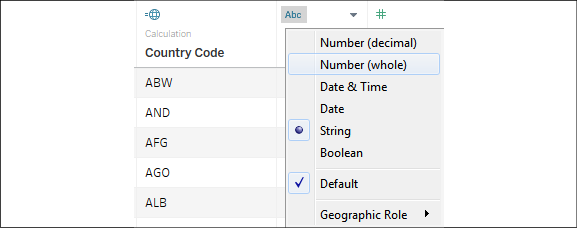
Figure 14.11: You can change the data types of the fields on the Data Source page
Alternatively, you could use the first drop-down menu in the Year field and select Create Calculated Field.... This would allow you to create a calculated field name Year (date), which parses the year string as a date with code such as DATE(DATEPARSE("yyyy", [Year])). This code will parse the string and then convert it into a simple date without a time. You can then hide the original Year field. You can hide any field, even if it is used in calculations, as long as it isn't used in a view. This leaves you with a very clean dataset.
The final cleaned, pivoted dataset is far easier to work with in Tableau than the original:
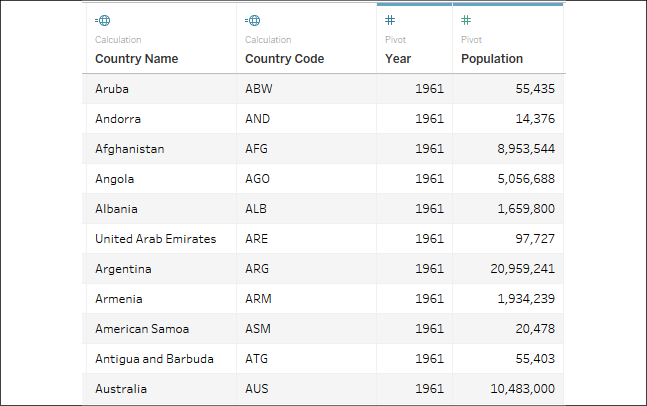
Figure 14.12: The cleaned and pivoted dataset
The data interpreter, cleaning options, and ability to pivot data (columns to rows) in Tableau make working with many datasets far easier. Next, we'll take a look at unions.
Unions
Often, you may have multiple individual files or tables that, together, represent the entire set of data. For example, you might have a process that creates a new monthly data dump as a new text file in a certain directory. Or, you might have an Excel file where data for each department is contained in a separate sheet.
A union is a concatenation of data tables that brings together rows of each table into a single table. For example, consider the following three tables of data:
Originals:
| Name | Occupation | Bank account balance |
|
Luke |
Farmer |
$2,000 |
|
Leia |
Princess |
$50,000 |
|
Han |
Smuggler |
-$20,000 |
Prequels:
| Name | Occupation | Bank account balance |
|
Watto |
Junk Dealer |
$9,000 |
|
Darth Maul |
Face Painter |
$10,000 |
|
Jar Jar |
Sith Lord |
-$100,000 |
Sequels:
| Name | Occupation | Bank account balance |
|
Rey |
Scavenger |
$600 |
|
Poe |
Pilot |
$30,000 |
|
Kylo |
Unemployed |
$0 |
A union of these tables would give a single table containing the rows of each individual table:
| Name | Occupation | Bank account balance |
|
Luke |
Farmer |
$2,000 |
|
Leia |
Princess |
$50,000 |
|
Han |
Smuggler |
-$20,000 |
|
Watto |
Junk Dealer |
$9,000 |
|
Darth Maul |
Face Painter |
$10,000 |
|
Jar Jar |
Sith Lord |
-$100,000 |
|
Rey |
Scavenger |
$600 |
|
Poe |
Pilot |
$30,000 |
|
Kylo |
Unemployed |
$0 |
Tableau allows you to union together tables from file-based data sources, including the following:
- Text files (
.csv,.txt, and other text file formats) - Sheets (tabs) within Excel documents
- Subtables within an Excel sheet
- Multiple Excel documents
- Google Sheets
- Relational database tables
Use the Data Interpreter feature to find subtables in Excel or Google Sheets. They will show up as additional tables of data in the left sidebar.
To create a union in Tableau, follow these steps:
- Create a new data source from the menu, toolbar, or Data Source screen, starting with one of the files you wish to be part of the union. Then, drag any additional files into the Drag table to union drop zone just beneath the existing table on the canvas (in either the logical or physical layers; though, the union, technically, exists in the physical layer):

Figure 14.13: You may create unions by dragging and dropping tables or files directly under existing tables on the canvas
- Once you've created a union, you can use the drop-down menu on the table in the designer to configure options for the union. Alternatively, you can drag the New Union object from the left sidebar into the designer to replace the existing table. This will reveal options to create and configure the union:

Figure 14.14: You may edit unions with these options
The Specific (manual) tab allows you to drag tables into and out of the union. The Wildcard (automatic) tab allows you to specify wildcards for filenames and sheets (for Excel and Google Sheets) that will automatically include files and sheets in the union based on a wildcard match.
Use the Wildcard (automatic) feature if you anticipate additional files being added in the future. For example, if you have a specific directory where data files are dumped on a periodic basis, the wildcard feature will ensure that you don't have to manually edit the connection.
- Once you have defined the union, you may use the resulting data source to visualize the data. Additionally, a union table may be joined with other tables in the designer window, giving you a lot of flexibility in working with data.
When you create a union, Tableau will include one or more new fields in your data source to help you to identify the file, sheet, and table where the data originated. Path will contain the file path (including the filename), Sheet will contain the sheet name (for Excel or Google Sheets), and Table Name will contain the subtable or text filename. You can use these fields to help you to identify data issues and also to extend your dataset as needed.
For example, if you had a directory of monthly data dump files, named 2020-01.txt, 2020-02.txt, 2020-03.txt, and so on, but no actual date field in the files, you could obtain the date using a calculated field with code such as the following:
DATEPARSE('yyyy-MM', [Table Name] )
In a union, Tableau will match the columns between tables by name. What happens when columns are not the same between tables or files? If you were to write a query to a database, you might expect a failed result as column names usually have to match exactly. However, Tableau allows you to union together files or tables with mismatched names.
Columns that exist in one file/table but not in others will appear as part of the union table, but values will be NULL in files/tables where the column does not exist. For example, if one of the files contained a column named Job instead of Occupation, the final union table would contain a column named Job and another named Occupation, with NULL values where the column did not exist. You can merge the mismatched columns by selecting the columns and using the drop-down menu. This will coalesce (keep the first non-null of) the values per row of data in a single new column:

Figure 14.15: Use Merge Mismatched Fields to combine columns resulting from a union where the field names didn't match (this mismatch is not included in the example data)
You do not have to merge mismatched fields. At times, there will not be corresponding matches in all files or tables and that may be useful for your analysis.
Unions allow you to bring together multiple files or tables with relatively the same structure and stack them together so that you end up with all records from all tables/files. With pivots and unions explored, we've covered two of the four basic transformation types. We'll continue with an example of how joins can be used to restructure your data.
Joins
You'll recall that the concept of joins and the types of joins were previously discussed in Chapter 13, Understanding the Tableau Data Model, Joins, and Blends. While joins are quite useful in bringing together tables in the same database or even disparate data sources (data contained in different systems and formats), they can be used to solve other data issues too, such as reshaping data to make it easier to meet your objectives in Tableau.
You can work through the following example in the Chapter 14 workbook, but the server database data source is simulated with a text file (Patient Visits.txt).
Let's say you have a table in a server database (such as SQL Server or Oracle) that contains one row per hospital patient and includes the Admit Date and Discharge Date as separate columns for each patient:
| Patient ID | Patient Name | Admit Date | Discharge Date |
|
1 |
David |
12/1/2018 |
12/20/2018 |
|
2 |
Solomon |
12/3/2018 |
12/7/2018 |
|
3 |
Asa |
12/5/2018 |
12/22/2018 |
|
4 |
Jehoshaphat |
12/5/2018 |
12/6/2018 |
|
5 |
Joash |
12/9/2018 |
12/16/2018 |
|
6 |
Amaziah |
12/10/2018 |
12/14/2018 |
|
7 |
Uzziah |
12/12/2018 |
12/24/2018 |
|
8 |
Jotham |
12/16/2018 |
12/29/2018 |
|
9 |
Hezekiah |
12/18/2018 |
12/22/2018 |
|
10 |
Josiah |
12/22/2018 |
12/23/2018 |
While this data structure works well for certain kinds of analyses, you would find it difficult to use if you wanted to visualize the number of patients in the hospital day by day for the month of December.
For one, which date field do you use for the axis? Even if you pivoted the table so that you had all of the dates in one field, you would find that you have gaps in the data. Sparse data, that is, data in which records do not exist for certain values, is quite common in certain real-world data sources. Specifically, in this case, you have a single record for each Admit or Discharge date, but no records for the days in between.
Sometimes, it might be an option to restructure the data at the source, but if the database is locked down, you may not have that option. You could also use Tableau's ability to fill in gaps in the data (data densification) to solve the problem. However, that solution could be complex and, potentially, brittle or difficult to maintain.
An alternative is to use a join to create the rows for all dates. In this case, we'll leverage a cross-database join to bring in another source of data altogether. You might quickly create an Excel sheet with a list of dates you want to see, like this:
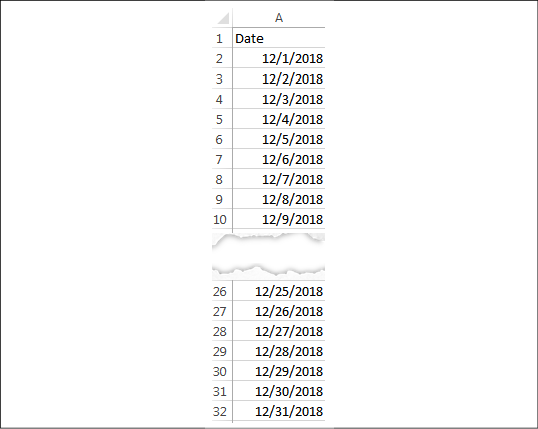
Figure 14.16: An Excel file containing only a comprehensive list of dates
The Excel file includes a record for each date. Our goal is to cross join (join every row from one table with every row in another) the data between the database table and the Excel table. With this accomplished, you will have a row for every patient for every date.
Joining every record in one dataset with every record in another dataset creates what is called a Cartesian product. The resulting dataset will have N1 * N2 rows (where N1 is the number of rows in the first dataset and N2 is the number of rows in the second). Take care in using this approach. It works well with smaller datasets. As you work with larger datasets, the Cartesian product may grow so large that this solution is untenable.
You'll often have specific fields in the various tables that will allow you to join the data together. In this case, however, we don't have any keys that define a join. The dates also do not give us a way to join all the data in a way that gives us the structure we want. To achieve the cross join, we'll use a join calculation. A join calculation allows you to write a special calculated field specifically for use in joins.
In this case, we'll select Create Join Calculation... for both tables and enter the single, hard-coded value, that is, 1, for both the left and right sides:
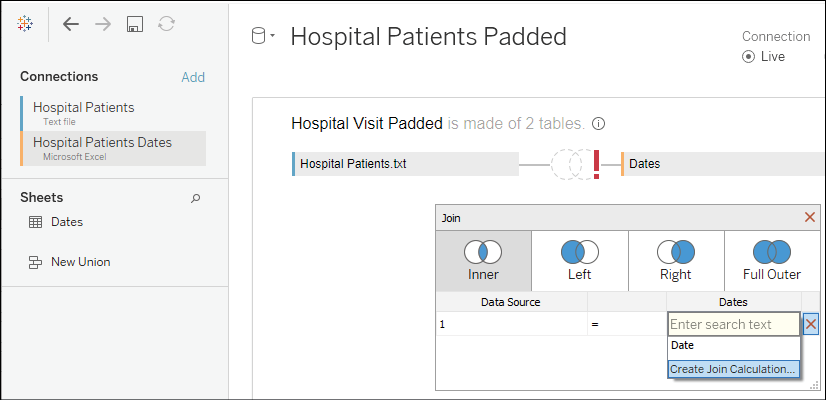
Figure 14.17: As we've seen, the join is created in the physical layer of the data model
Since 1 in every row on the left matches 1 in every row on the right, we get every row matching every row—a true cross join.
As an alternative, with many other server-based data sources, you can use Custom SQL as a data source. On the Data Source screen, with the Patient Visits table in the designer, you could use the top menu to select Data | Convert to Custom SQL to edit the SQL script that Tableau uses for the source. Alternatively, you can write your own custom SQL using the New Custom SQL object on the left sidebar.
The script in this alternative example has been modified to include 1 AS Join to create a field, called Join, with a value of 1 for every row (though, if you didn't do this in the script, you could simply use a join calculation). Fields defined in Custom SQL can also be used in joins:

Figure 14.18: A sample script that could be used to create a value on which to join
Based on the join calculation, our new cross-joined dataset contains a record for every patient for every date, and we can now create a quick calculation to see whether a patient should be counted as part of the hospital population on any given date. The calculated field, named Patients in Hospital, has the following code:
IF [Admit Date] <= [Date] AND [Discharge Date] >= [Date]
THEN 1
ELSE 0
END
This allows us to easily visualize the flow of patients, and even potentially perform advanced analytics based on averages, trends, and even forecasting:

Figure 14.19: A visualization of the daily hospital population, made easy with some data restructuring
Ultimately, for a long-term solution, you might want to consider developing a server-based data source that gives the structure that's needed for the desired analysis. However, a join here allowed us to achieve the analysis without waiting on a long development cycle.
Having considered examples of pivots, unions, and joins, let's turn our focus to an example of the final major transformation type: aggregation.
Aggregation
Remember that the two keys to a good data structure are as follows:
- Having a level of detail that is meaningful
- Having measures that match the level of detail or that are possibly at higher levels of detail
Measures at lower levels tend to result in wide data and can make some analysis difficult or even impossible. Measures at higher levels of detail can, at times, be useful. As long as we are aware of how to handle them correctly, we can avoid some pitfalls.
Consider, for example, the following data (included as Apartment Rent.xlsx in the Chapter 14 directory), which gives us a single record each month per apartment:

Figure 14.20: The Apartment Rent data, which is poorly structured because the Square Feet measure is repeated for every month
The two measures are really at different levels of detail:
- Rent Collected matches the level of detail of the data where there is a record of how much rent was collected for each apartment for each month.
- Square Feet, on the other hand, does not change month to month. Rather, it is at the higher level of detail, of Apartment only.
Tableau's data model would make this data very easy to work with if it was contained in two tables at the correct level of detail. If it was in a relational database where we could use a custom SQL statement to create a couple of tables at the right level of detail, we might consider that approach. In the next chapter, we'll consider how Tableau Prep could be used to easily solve this problem. For now, work through the details to gain some understanding of how to deal with aggregation issues if you are faced with a similar poor structure (and you'll gain an immense appreciation for what Tableau Prep and the Tableau data model can do!).
The difference in levels of detail can be observed when we remove the date from the view and look at everything at the Apartment level:

Figure 14.21: An illustration of how various aggregations might be right or wrong depending on the level of detail
Notice that the SUM(Rent Collected) makes perfect sense. You can add up the rent collected per month and get a meaningful result per apartment. However, you cannot Sum Square Feet and get a meaningful result per apartment. Other aggregations, such as average, minimum, and maximum, do give the right results per apartment.
However, imagine that you were asked to come up with the ratio of total rent collected to square feet per apartment. You know it will be an aggregate calculation because you have to sum the rent that's collected prior to dividing. But which of the following is the correct calculation?
SUM([Rent Collected])/SUM([Square Feet])SUM([Rent Collected])/AVG([Square Feet])SUM([Rent Collected])/MIN([Square Feet])SUM([Rent Collected])/MAX([Square Feet])
The first one is obviously wrong. We've already seen that square feet should not be added each month. Any of the final three would be correct if we ensure that Apartment continues to define the level of detail of the view.
However, once we look at the view that has a different level of detail (for example, the total for all apartments or the monthly total for multiple apartments), the calculations don't work. To understand why, consider what happens when we turn on the column grand totals (from the menu, select Analysis | Totals | Show Column Grand Totals, or drag and drop Totals from the Analytics tab):

Figure 14.22: None of the aggregations work to give us a grand total
The problem here is that the Grand Total line is at the level of detail of all apartments (for all months). What we really want as the Grand Total of square feet is 900 + 750 = 1,650. However, here, the sum of square feet is the addition of square feet for all apartments for all months. The average won't work. The minimum finds the value 750 as the smallest measure for all apartments in the data. Likewise, the maximum picks 900 as the single largest value. Therefore, none of the proposed calculations would work at any level of detail that does not include the individual apartment.
You can adjust how subtotals and grand totals are computed by clicking on the individual value and using the drop-down menu to select how the total is computed. Alternatively, right-click on the active measure field and select Total Using. You can change how all measures are totaled at once from the menu by selecting Analysis | Totals | Total All Using. Using this two-pass total technique could result in correct results in the preceding view, but it would not universally solve the problem. For example, if you wanted to show the price per square foot for each month, you'd have the same issue.
Fortunately, Tableau gives us the ability to work with different levels of detail in a view. Using Level of Detail (LOD) calculations, which we encountered in Chapter 5, Leveraging Level of Detail Calculations, we can calculate the square feet per apartment.
Here, we'll use a fixed LOD calculation to keep the level of detail fixed at the apartment level. We'll create a calculated field, named Square Feet per Apartment, with the following code:
{ INCLUDE [Apartment] : MIN([Square Feet]) }
The curly braces surround a LOD calculation and the keyword INCLUDE indicates that we want to include Apartment as part of the level of detail for the calculation, even if it is not included in the view level of detail. MIN is used in the preceding code, but MAX or AVG could have been used as well because all give the same result per apartment.
As you can see, the calculation returns the correct result in the view at the apartment level and at the grand total level, where Tableau includes Apartment to find 900 (the minimum for A) and 750 (the minimum for B) and then sums them to get 1,650:

Figure 14.23: An LOD calculation gives us the correct result at all levels of detail
Now, we can use the LOD calculated field in another calculation to determine the desired results. We'll create a calculated field, named Rent Collected per Square Foot, with the following code:
SUM([Rent Collected])/SUM([Square Feet per Apartment])
When that field is added to the view and formatted to show decimals, the final outcome is correct:

Figure 14.24: The LOD expression gives us the foundation for even more complexity, such as calculating the rent per area
Alternatively, instead of using INCLUDE, we could have used a FIXED level of detail, which is always performed at the level of detail of the dimension(s) following the FIXED keywords, regardless of what level of detail is defined in the view. This would have told Tableau to always calculate the minimum square feet per apartment, regardless of what dimensions define the view level of detail. While very useful, be aware that the FIXED LOD calculations are calculated for the entire context (either the entire dataset or the subset defined by the context filters). Using them without understanding this can yield unexpected results.
For now, we've learned how to handle some aggregation issues; however, in the next chapter, we'll explore how we can truly transform the data with aggregations to make problems like the previous exercise much easier. In the meantime, let's consider some alternative fixes for data problems.
Overview of advanced fixes for data problems
In addition to the techniques that we mentioned earlier in this chapter, there are some additional possibilities to deal with data structure issues. It is outside the scope of this book to develop these concepts fully. However, with some familiarity of these approaches, you can broaden your ability to deal with challenges as they arise:
- Custom SQL: It can be used in the data connection to resolve some data problems. Beyond giving a field for a cross-database join, as we saw earlier, custom SQL can be used to radically reshape the data that's retrieved from the source. Custom SQL is not an option for all data sources, but it is an option for many relational databases. Consider a custom SQL script that takes the wide table of country populations we mentioned earlier in this chapter and restructures it into a tall table:
SELECT [Country Name],[1960] AS Population, 1960 AS Year FROM Countries UNION ALL SELECT [Country Name],[1961] AS Population, 1961 AS Year FROM Countries UNION ALL SELECT [Country Name],[1962] AS Population, 1962 AS Year FROM Countries ... ...And so on. It might be a little tedious to set up, but it will make the data much easier to work with in Tableau! However, many data sources using complex custom SQL will need to be extracted for performance reasons.
- Table calculations: Table calculations can be used to solve a number of data challenges, from finding and eliminating duplicate records to working with multiple levels of detail. Since table calculations can work within partitions at higher levels of detail, you can use multiple table calculations and aggregate calculations together to mix levels of detail in a single view. A simple example of this is the Percent of Total table calculation, which compares an aggregate calculation at the level of detail in the view with a total at a higher level of detail.
- Data blending: Data blending can be used to solve numerous data structure issues. Because you can define the linking fields that are used, you can control the level of detail of the blend.
- Data scaffolding: Data scaffolding extends the concept of data blending. With this approach, you construct a scaffold of various dimensional values to use as a primary source and then blend them to one or more secondary sources. In this way, you can control the structure and granularity of the primary source while still being able to leverage data that's contained in the secondary sources.
- Data model: Data blending is useful when you need to control the level of the relationship per view. If the relationship is better defined, the data model will give you incredible power to relate tables that are at different levels of detail and have confidence that aggregations will work correctly.
Summary
Up until this chapter, we'd looked at data that was, for the most part, well-structured and easy to use. In this chapter, we considered what constitutes a good structure and ways to deal with poor data structures. A good structure consists of data that has a meaningful level of detail and that has measures that match that level of detail. When measures are spread across multiple columns, we get data that is wide instead of tall.
We also spent some time understanding the basic types of transformation: pivots, unions, joins, and aggregations. Understanding these will be fundamental to solving data structure issues.
You also got some practical experience in applying various techniques to deal with data that has the wrong shape or has measures at the wrong level of detail. Tableau gives us the power and flexibility to deal with some of these structural issues, but it is far preferable to fix a data structure at the source.
In the next chapter, we'll take a brief pause from looking at Tableau Desktop to consider Tableau Prep, another alternative to tackle challenging data!
